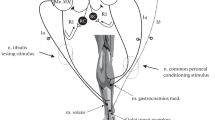Summary
The neurographic activity evoked either by stimulation of the tibial nerve at the popliteal fossa or by percussion of the Achilles tendon has been recorded at lumbar and thigh levels, in order to find out whether conduction time, temporal dispersion and central delay of the neural volleys underlying the monosynaptic reflex (H or T) may change (a) as a function of stimulus intensity; (b) under facilitatory or inhibitory experimental conditions; (c) “spontaneously”, i.e. during the steady state.
The reflexly evoked ventral root discharge (VRD) decreases in latency with increasing stimulus intensity up to the maximum reflex response in the absence of changes in afferent (thigh to spine) or efferent (spine to thigh) conduction times. Reduction of the central delay was greater with mechanical than electrical stimulation, probably due to the combined effect of spatial and temporal summation under the former experimental condition. The latency of the VRD related to the maximal H response was not further modified by supramaximal stimulus strengths. The Jendrassik manœuvre caused a significant decrease in latency of the VRD, the opposite effect being observed during calf muscle vibration. A significant relationship between amplitude and latency of single VRD s could be demonstrated during the “steady state”. Our data point to the existence of a positive correlation between the size of the motoneuronal pool activated by an afferent volley and speed of transmission in the reflex pathway, both during the “steady state” and under either facilitatory or inhibitory experimental conditions, provided that the test stimulus strength does not exceed the maximum reflex response (H or T). No detectable signs of peripheral dispersion of the VRD could be demonstrated, irrespective of the stimulus employed: this suggests that the axon diameters of the moto-neurones contributing to the monosynaptic reflex fall within a fairly narrow distribution
Similar content being viewed by others
References
Abbruzzese M, Ratto S, Abbruzzese G, Favale E (1985) Electroneurographic correlates of the monosynaptic reflex: experimental studies and normative data. J Neurol Neurosurg Psychiat 48: 434–444
Bawa P, Binder MD, Ruenzel P, Henneman E (1984) Recruitment order of motoneurones in stretch reflexes is highly correlated with their axonal conduction velocity. J Neurophysiol 52: 410–420
Buchthal F, Rosenfalck A (1966) Evoked action potentials and conduction velocity in human sensory nerves. Brain Res 3: 1–122
Burke D, Gandevia SC, McKeon B (1983) The afferent volleys responsible for spinal proprioceptive reflexes in man. J Physiol (Lond) 339: 535–552
Burke D, Gandevia SC, McKeon B (1984) Monosynaptic and oligosynaptic contributions to human ankle jerk and H-reflex. J Neurophysiol 52: 435–448
Burke D, Hagbarth K-E, Wallin G (1980a) Alpha-gamma linkage and the mechanisms of reflex reinforcement. In: Desmedt JE (ed) Spinal and supraspinal mechanisms of voluntary motor control and locomotion. Progress in Clinical Neurophysiology, Vol 8. Karger, Basel, pp 170–180
Burke D, Hagbarth K-E, Wallin G, Lofstedt L (1980b) Muscle spindle activity induced by vibration in man: implications for the tonic stretch reflex. In: Desmedt JE (ed) Spinal and supraspinal mechanisms of voluntary motor control and locomotion. Progress in Clinical Neurophysiology, Vol 8. Karger, Basel, pp 243–253
Burke D, McKeon B, Skuse NF (1981) Dependence of the Achilles reflex on the excitability of spinal reflex pathways. Ann Neurol 10: 551–556
Burke RE, Rudomin P (1977) Spinal neurones and synapses. In: Brookhart JM, Mountcastle VB (eds) Handbook of physiology. The nervous system, Vol I, Part 2. Am Physiol Soc, Bethesda MD, pp 877–944
Claman HP, Ngai AC, Kukula CG, Goldberg SJ (1983) Motor pool organization in monosynaptic reflexes: responses in three different muscles. J Neurophysiol 50: 725–742
Cocquery JM, Mark RF, Paillard J (1962) Les fluctuations spontanées du réflexe de Hoffmann à differents niveaux de la courbe de recrutement. Electroenceph Clin Neurophysiol Suppl 22: 90–92
Diamantopoulos E, Gassei MM (1965) Electrically induced monosynaptic reflexes in man. J Neurol Neurosurg Psychiat 28: 496–502
Eccles JC (1957) The physiology of nerve cells. Johns Hopkins Press, Baltimore
Eisen A, Odusote K (1979) Amplitude of the F-wave: a potential means of documenting spasticity. Neurology 29: 1306–1309
Hagbarth K-E, Wallin G, Burke D, Lofstedt L (1975) Effects of the Jendrassik manuvre on muscle spindle activity in man. J Neurol Neurosurg Psychiat 38: 1143–1153
Lloyd DPC (1943) Conduction and synaptic transmission of reflex response to stretch in spinal cats. J Neurophysiol 6: 317–326
Paillard J (1955) Réflexes et régulations d'origine proprioceptive chez l'homme. Etude neurophysiologique et psychophysiologique. Arnette, Paris
Ratto S, Abbruzzese M, Reni L, Favale E (1985) Neurographic evidence of facilitation and inhibition of synaptic transmission in human spinal cord. Electroenceph Clin Neurophysiol 61: S207
Stalberg E, Trontelj JV (1979) Single fibre electromyography. The Mirvalle Press Limited, Old Woking, Surrey, pp 151–168
Teasdall RD, Magladery JW (1974) Brachioradialis reflex and contraction of forearm flexors. Arch Neurol 30: 94–95
Trontelj JV (1973) A study of the H-reflex by single fibre EMG. J Neurol Neurosurg Psychiat 36: 951–959
Vedel JP, Roll JP, Ribot E (1985) Enregistrement unitaire de fibres skeletomotrices et fusimotrices chez l'homme. J Physiol (Paris) 80: 31A
Wiederholt WC (1970a) Stimulus intensity and site of excitation in human median nerve sensory fibres. J Neurol Neurosurg Psychiat 33: 438–441
Wiederholt WC (1970b) Threshold and conduction velocity in isolated mixed mammalian nerves. Neurology 20: 347–352
Author information
Authors and Affiliations
Rights and permissions
About this article
Cite this article
Ratto, S., Reni, L., Abbruzzese, G. et al. Facilitation and inhibition of synaptic transmission in the spinal cord: an electroneurographic study in humans. Exp Brain Res 64, 411–420 (1986). https://doi.org/10.1007/BF00340478
Received:
Accepted:
Issue Date:
DOI: https://doi.org/10.1007/BF00340478



